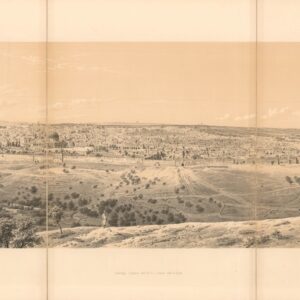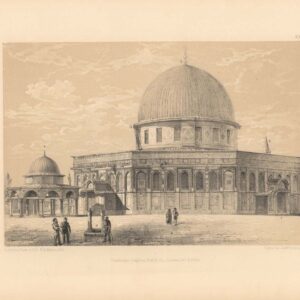An excellent example of Braun and Hogenberg’s 1575 bird’s-eye-view of Damascus in original black and white.
Damascus, urbs noblissima ad Libanum montem, Totius Sÿriae Metropolis
$775
1 in stock
Description
This is Braun and Hogenberg’s ca. 1575 bird’s-eye-view of the city of Damascus. There are other color examples on the market; this example is for someone looking for original black and white, engraved with a strong impression. The view was originally published in the second volume of Braun and Hogenberg’s Civitates Orbis Terrarum, history’s first work dedicated to city plans.
The details of this view are characterized by an interplay between two different themes in the history of Damascus itself. The first theme is the city’s role in the New Testament. On the back of the map there is text in Latin that tells the story of the conversion of Paul the Apostle on the road to Damascus, in which Saul/Paul became a follower of Christ and ceased to persecute early Christians. The text relates that: “A stone’s throw away from Damascus is the place where Christ appeared to Paul as he persecuted the Christians, and called out to him: ‘Saul, Saul, why are you persecuting Me?’ On this site Christians now have their cemetery and a church.” This pivotal biblical event is memorialized in the view in the lower left corner, where we see a depiction of the aforementioned church. In addition, at top left, the view makers have located the spot where Cain struck Abel dead.
Juxtaposing the ancient, Christian history of the city depicted in the view is its contemporary, late 16th century context. At the time of its publication, Damascus was under Ottoman control. The Ottoman Empire, despite its defeat in the naval battle of Lepanto a few years before the publication of Civitates Orbis Terrarum, remained one of the world’s great empires. It is easy to imagine a reader opening up this view, seeing an image of Damascus for the first time, and feeling a mixture of fascination and trepidation. Braun and Hogenberg have heightened the sense of the exotic with a pair of figures in the foreground, wearing turbans and engaged in discussion, along with riders with camels approaching the gates of the city.
The depiction of Damascus itself is a mix of fantasy and reality. It is set against the backdrop of mountains, and the Barada River cuts through the city. We see the city walls and a variety of monuments. The latter are often based on actual structures, but have been given an overly Ottoman character, for example the Great Mosque of Damascus, which is depicted more like something we’d expect to see in Istanbul rather than the true 8th century Umayyad architecture. The Church of St. Paul, located just right of center, lies in ruins, perhaps extenuating the the sense of loss for a Christian audience.
Cartographer(s):
Georg Braun (1541–1622) was a German geographer, publisher, and the canon of the Cologne chapter of St. Maria ad Gradus. From 1572, he edited the Civitates orbis terrarum, which contains 546 prospects, bird’s-eye views, and maps of cities from all around the world. As the principal editor, Braun acquired the tables, hired the various artists and contributors, and wrote the texts. He oversaw the project from its inception until its completion in 1617.
The main engraver for volumes I-IV of the Civitates orbis terrarum was Frans Hogenberg (1535–1590), a Flemish painter, engraver, and mapmaker, born in Mechelen and later established in Cologne. Hogenberg was a Protestant exile from the Spanish Netherlands who had worked with Abraham Ortelius on his iconic Theatrum Orbis Terrarum. His detailed depictions of architecture, figures, and heraldry helped define the genre of the Renaissance bird’s-eye view. By the time of his death in 1590, Hogenberg had secured his reputation as one of the era’s foremost cartographic artists.
Condition Description
Clean, excellent condition. Some repair visible on verso.
References
Rumsey 12126.000. OCLC 707613523. Fussel, Cities of the World pp. 192-93. Taschen p. 194.


![[Old Damascus]](https://neatlinemaps.com/wp-content/uploads/2019/09/NL-00657-scaled-300x300.jpg)
![[Old Damascus]](https://neatlinemaps.com/wp-content/uploads/2019/09/NL-00657-scaled.jpg)
